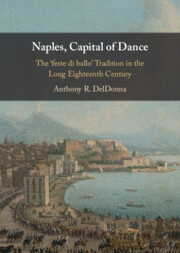Book contents
- Naples, Capital of Dance
- Naples, Capital of Dance
- Copyright page
- Dedication
- Contents
- Figures
- Tables
- Music Examples
- Acknowledgments
- Introduction
- 1 Celebratory Balls in the Kingdom of Naples
- 2 The Politics of Place and Spheres of Power
- 3 Seasons of Feste 1737 and 1747
- 4 The Dance Treatise in the Age of Reason
- 5 Seasons of Splendor
- 6 A Return to the Capital
- 7 Behind the Scenes, Between the Lines
- 8 The Neapolitan feste di ballo as (Historical) Soundscape
- Select Bibliography
- Index
1 - Celebratory Balls in the Kingdom of Naples
Published online by Cambridge University Press: 10 April 2025
- Naples, Capital of Dance
- Naples, Capital of Dance
- Copyright page
- Dedication
- Contents
- Figures
- Tables
- Music Examples
- Acknowledgments
- Introduction
- 1 Celebratory Balls in the Kingdom of Naples
- 2 The Politics of Place and Spheres of Power
- 3 Seasons of Feste 1737 and 1747
- 4 The Dance Treatise in the Age of Reason
- 5 Seasons of Splendor
- 6 A Return to the Capital
- 7 Behind the Scenes, Between the Lines
- 8 The Neapolitan feste di ballo as (Historical) Soundscape
- Select Bibliography
- Index
Summary
Chapter 1 offers a précis of the feste di ballo in Naples from the ascension of Carlo di Borbone in 1734 to the long reign of his son Ferdinando IV, whose Austrian consort, Maria Carolina, remained a significant patron in local artistic life. It considers the Neapolitan milieu against the backdrop of the wider European diffusion and patronage of social dance, especially in Paris (Carlo’s great-grandfather was Louis XIV), Milan, and Rome. The contemporary letters of Alessandro and Pietro Verri provide firsthand insights into the existence of similar feste di ballo, and their influence and social resonance in these cosmopolitan cities. The deep interest of Ferdinando and Maria Carolina from the very beginning of their reign in the second half of the eighteenth century encouraged their active engagement in the programming of feste di ballo. Their well-known passion for social dancing extended from the direct planning thereof to taking center stage in the public performance of the minuet and contradance, as well as requiring the study of dance for their children. These circumstances were meticulously documented in the contemporary periodicals Gazzetta Universale and Notizie del Mondo, and in the personal correspondence and diaries discussed here.
Keywords
- Type
- Chapter
- Information
- Naples, Capital of DanceThe ‘feste di ballo' Tradition in the Long Eighteenth Century, pp. 7 - 27Publisher: Cambridge University PressPrint publication year: 2025

